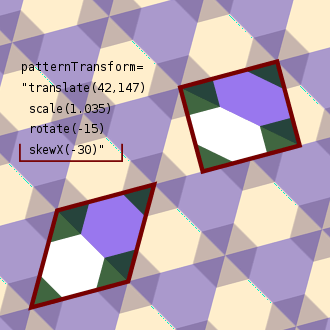Transformation (function)
In mathematics, a transformation is a function f (usually with some geometrical underpinning) that maps a set X to itself, i.e. f : X → X.[1][2][3][4] In other areas of mathematics, a transformation may simply refer to any function, regardless of domain and codomain.[5] For this wider sense of the term, see function (mathematics).

which transforms a rectangular repetitive pattern
into a rhombic pattern. The four transformations are linear.
Examples include linear transformations of vector spaces and geometric transformations, which include projective transformations, affine transformations, and specific affine transformations, such as rotations, reflections and translations.[6][7]
More generally, a transformation in mathematics means a mathematical function (synonyms: "map" or "mapping"). A transformation can be an invertible function from a set X to itself, or from X to another set Y. The choice of the term transformation may simply indicate that the geometric aspects of a function are being considered (for example, with respect to invariants).
Algebraic structures
The set of all transformations on a given base set, together with function composition, forms a regular semigroup.
Combinatorics
For a finite set of cardinality n, there are nn transformations and (n+1)n partial transformations.[9]
See also
- Coordinate transformation
- Data transformation (statistics)
- Geometric transformation
- Infinitesimal transformation
- Linear transformation
- Rigid transformation
- Transformation geometry
- Transformation semigroup
- Transformation group
- Transformation matrix
References
- "The Definitive Glossary of Higher Mathematical Jargon — Transformation". Math Vault. 2019-08-01. Retrieved 2019-12-13.
- Olexandr Ganyushkin; Volodymyr Mazorchuk (2008). Classical Finite Transformation Semigroups: An Introduction. Springer Science & Business Media. p. 1. ISBN 978-1-84800-281-4.
- Pierre A. Grillet (1995). Semigroups: An Introduction to the Structure Theory. CRC Press. p. 2. ISBN 978-0-8247-9662-4.
- Wilkinson, Leland & Graham (2005). The Grammar of Graphics (2nd ed.). Springer. p. 29. ISBN 978-0-387-24544-7.CS1 maint: uses authors parameter (link)
- P. R. Halmos (1960). Naive Set Theory. Springer Science & Business Media. pp. 30–. ISBN 978-0-387-90092-6.
- "Transformations". www.mathsisfun.com. Retrieved 2019-12-13.
- "Types of Transformations in Math". Basic-mathematics.com. Retrieved 2019-12-13.
- Christopher Hollings (2014). Mathematics across the Iron Curtain: A History of the Algebraic Theory of Semigroups. American Mathematical Society. p. 251. ISBN 978-1-4704-1493-1.
- Olexandr Ganyushkin; Volodymyr Mazorchuk (2008). Classical Finite Transformation Semigroups: An Introduction. Springer Science & Business Media. p. 2. ISBN 978-1-84800-281-4.